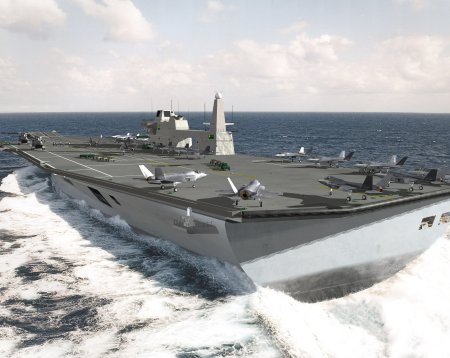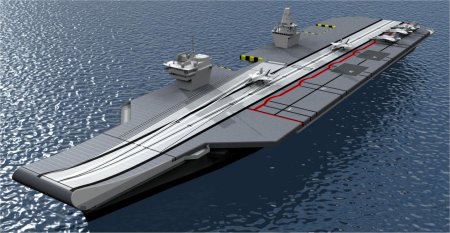At the end of January, the UK government is due to select the prime contractor for the Royal Navy's future aircraft carriers (CVFs). The Ministry of Defence has allocated £3 billion ($4.7 billion) for the ship acquisition, while in-service support is budgeted at a further £6.5 billion. As with many other UK procurements, the CVF competition is a battle being fought by two companies, BAE Systems and Thales.
Two conventionally powered, 50,000t-class ships are planned to replace the three significantly smaller Invincible-class carriers from 2012. The carriers are a key element of the UK's deployable forces and has participated in all recent operations. The CVFs will operate alongside the dedicated helicopter carrier HMS Ocean and two new aviation-capable assault ships - HMS Albion and HMS Bulwark.
The CVF acquisition is integral to two other programmes: the Joint Combat Aircraft (JCA) and Maritime Airborne Surveillance Capability (MASC). JCA - the UK's procurement of Lockheed Martin F-35 Joint Strike Fighters - influences the size and shape of the carrier, which in turn imposes limitations on MASC, the CVF's organic airborne early warning and control element. The UK has committed £2 billion to the JSF system development and demonstration phase, while procuring up to 150 aircraft will add £10 billion to the bill. MASC is in the study phase, with BAE and Thales once again competing. The go-ahead decision for MASC is due in 2006.
In September, the MoD confirmed selection of the short take-off and vertical landing (STOVL) F-35, rejecting the US Navy's CV conventional carrier version. Although choosing STOVL meant the MoD could specify a slightly smaller carrier, however, it opted for the larger CV ship, telling BAE and Thales to refine their designs, modifying the larger ship for STOVL operations, and keeping the option of converting the CVFs to conventional operations at a later stage.
The MoD believes that the fact it is "fitted for but not with" the catapults and arrestor gear required for CV operations will ensure the CVFs can meet the intended 50-year service life. But, as some industry observers note, it also provides a fall-back position, should the US Marine Corps alter its plans to acquire 609 STOVL JSFs, or if the programme runs into technical difficulties.

Future proofing
Announcing the decision in September, defence procurement minister Lord Bach said the strategy "future-proofs" the ships, as the JSF may not be replaced by a STOVL-capable aircraft. Chief of defence procurement Sir Robert Walmsley says building the CVF slightly larger than strictly necessary will cost up to £150 million extra, but this is significantly less than trying to adapt the ships in 30 years' time. It has already been suggested that JSF will be the last manned naval fighter, and that unmanned combat air vehicles (UCAVs) will assume the role. STOVL UCAVs are less likely to be developed, say industry observers.
In theory, the STOVL JSF decision limits MASC to a helicopter or tiltrotor platform - although both competitors are unofficially considering short take-off but arrested landing (STOBAR) as a means for allowing the operation of a fixed-wing MASC platform (Flight International, 5-11 November). The CVF air wing is planned to comprise 48 JSFs, four MASCs and six AgustaWestland EH101/Merlin helicopters, and is intended to fly up to 110 sorties a day.
With the JSF variant chosen, the most important forthcoming decision is selection of the CVF prime contractor. BAE and Thales are locked in a bitter battle, the former fighting to preserve its home market, and the latter trying to build on its acquisition of Racal to become the UK's second major defence contractor.
The design phase ended in late November, so the companies now await the MoD's decision. Both have created large teams and intend to use the bulk of the UK's shipbuilding capacity to complete the vessels in blocks that will be integrated by a single yard. Following downselection, the submission for the final go-ahead decision - the so-called "main gate" - is due at the end of next October, with a contract signature expected in April 2004.
Thales managing director naval UK, Peter Robinson, says the company has recruited KBR to manage the shipbuilding; BMT to assist with ship design; Alston to provide "electric ship" expertise, which includes work on the RN's Type 45 anti-air warfare destroyers; Devonport Management (DML), which runs the RN's shore-based naval facilities, to be responsible for through-life-support; and CAE to provide the ship management system, which, says Robinson, will be de-risked using commercial technology developed for the Queen Mary 2 liner.
Others involved include Lockheed Martin, providing the aviation knowledge; UK research company Qinetiq; and Raytheon. The combination of Raytheon and Thales means the team has access to key suppliers on the French and US carrier programmes, the only other large CV projects in the world.
Thales has divided its vessels into five "superblocks" running from the keel to the top of the ship. These will be built in separate yards as self-contained, fully functioning units, and towed to a final assembly site. If Thales is successful, first metal would be cut in late 2005. The future of UK shipbuilding, other industrial participation, as well as the prospect of giving a £3 billion contract to a French-owned company, have been major elements in the CVF campaign. Robinson says the Thales solution will be "100% designed and constructed in the UK".
He adds that the ship/air interface is a key element of the design - for instance the hangar deck is high enough to allow any aircraft to be maintained anywhere, eliminating the need to move airframes around during maintenance. Flying control (flyco) is in a separate island from the ship's bridge, providing command-and-control redundancy for the ship as a whole, but also improving wind-over-deck characteristics, says Robinson. The concept also separates some of the ship's principal sensors, reducing interference effects and eliminating some trunking within the ship for cooling intakes and exhaust flows. The Thales design also has two deck lifts - one between the two islands and one aft of the flyco position.
BAE's CVF design is also divided into sections. Three "megablocks" will form the hull up to the hangar-deck level, while the hangar sides, flight deck and island complete the build plan. BAE owns most of the UK's military shipbuilding capability and is prime contractor for the Type 45, the Astute submarine class and the two assault ships.

Supplier team
The company's supplier team includes BAE joint venture AMS, which will supply the battle-management system, working with BAE, Lockheed Martin and Northrop Grumman. AMS will also supply information systems and systems engineering; Babcock BES will be responsible for the ship build strategy and participate in through-life support; EDS will provide systems integration; and Fleet Support will also assist in through-life support. As with Thales, Lockheed Martin will provide aviation back-up and programme management.
Northrop Grumman, an F-35 partner with BAE and Lockheed Martin, will also supply mission planning, air traffic control and - as the USN's prime ship supplier - contribute to the ship-build strategy. Other team members include BAE's Type 45 partner VT Shipbuilding, Qinetiq and Rolls-Royce, which will supply the propulsion system, and Swan Hunter.
BAE head of aviation and systems Peter Fish says the company's CVF design has three lifts - one of which emerges in the middle of the carrier's "novel island", designed to provide a better footprint for the antenna farm.
Fish says the CVF and JSF offer the chance to improve STOVL operations significantly over today's BAE Sea Harrier FA2/Harrier GR7/a. Options for the vertical-landing element include approaching over the ship's stern rather than coming alongside and manoeuvring over the landing spot. This offers an improved landing rate and addresses environmental issues - such as the jet exhaust down-blast associated with landing-on. The JSF's improved STOVL handling and control will be a factor in allowing this, while the aircraft's electro-optical sensors offer opportunities to present the pilot with improved cueing.
Full investigation of such concepts will have to wait until the CVF and JSF are available for trials around the end of this decade. But it is still far from certain that the CVF programme will progress as far as service entry. Main gate is not due until next year, and many observers believe the MoD will struggle to find the money for the ships without slashing other programmes - financial stringency is already affecting MASC.
Winning next month's downselection may be only the first of several hurdles the winning bidder, the RN and the programme face before 2012.
Source: Flight International


























